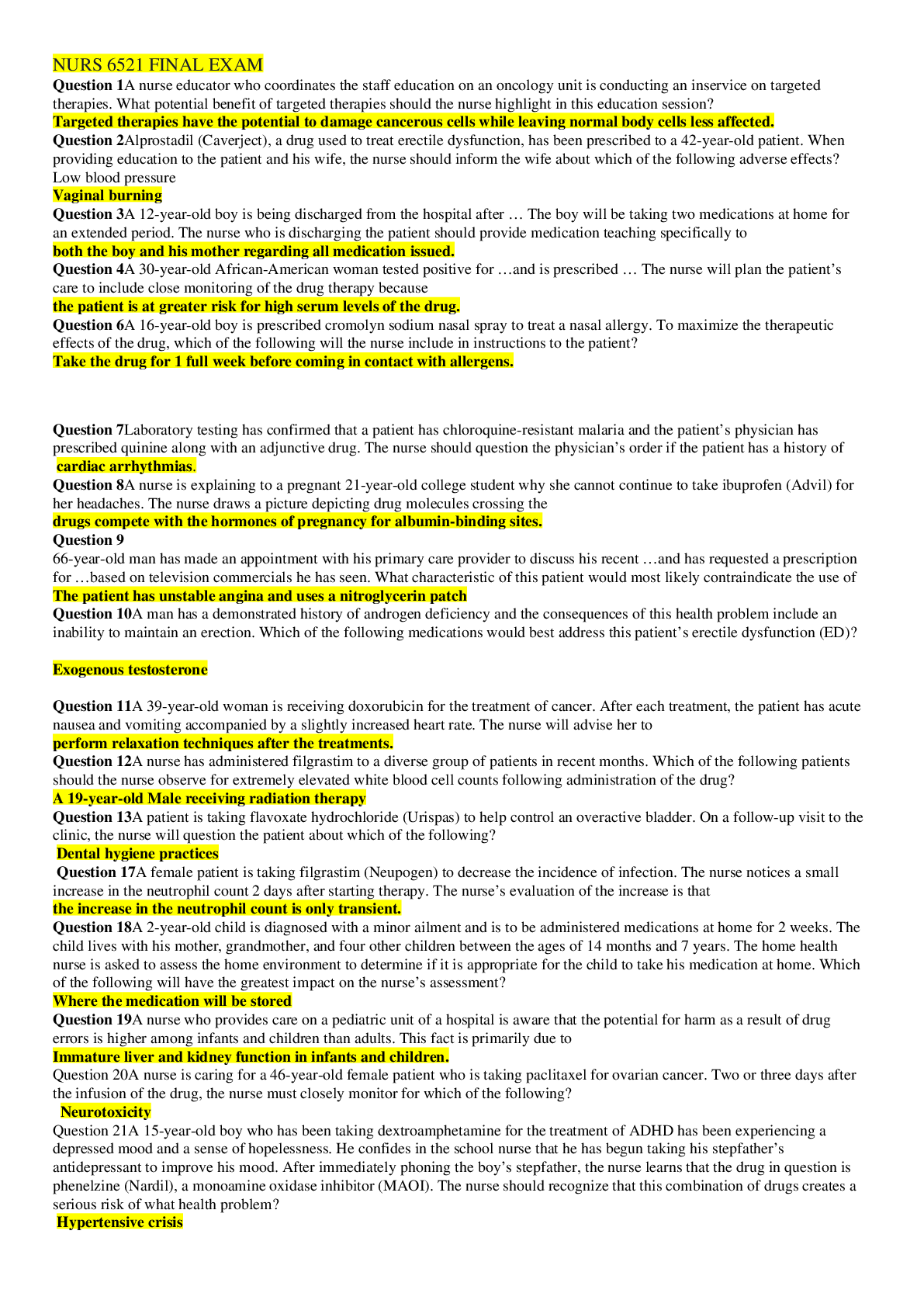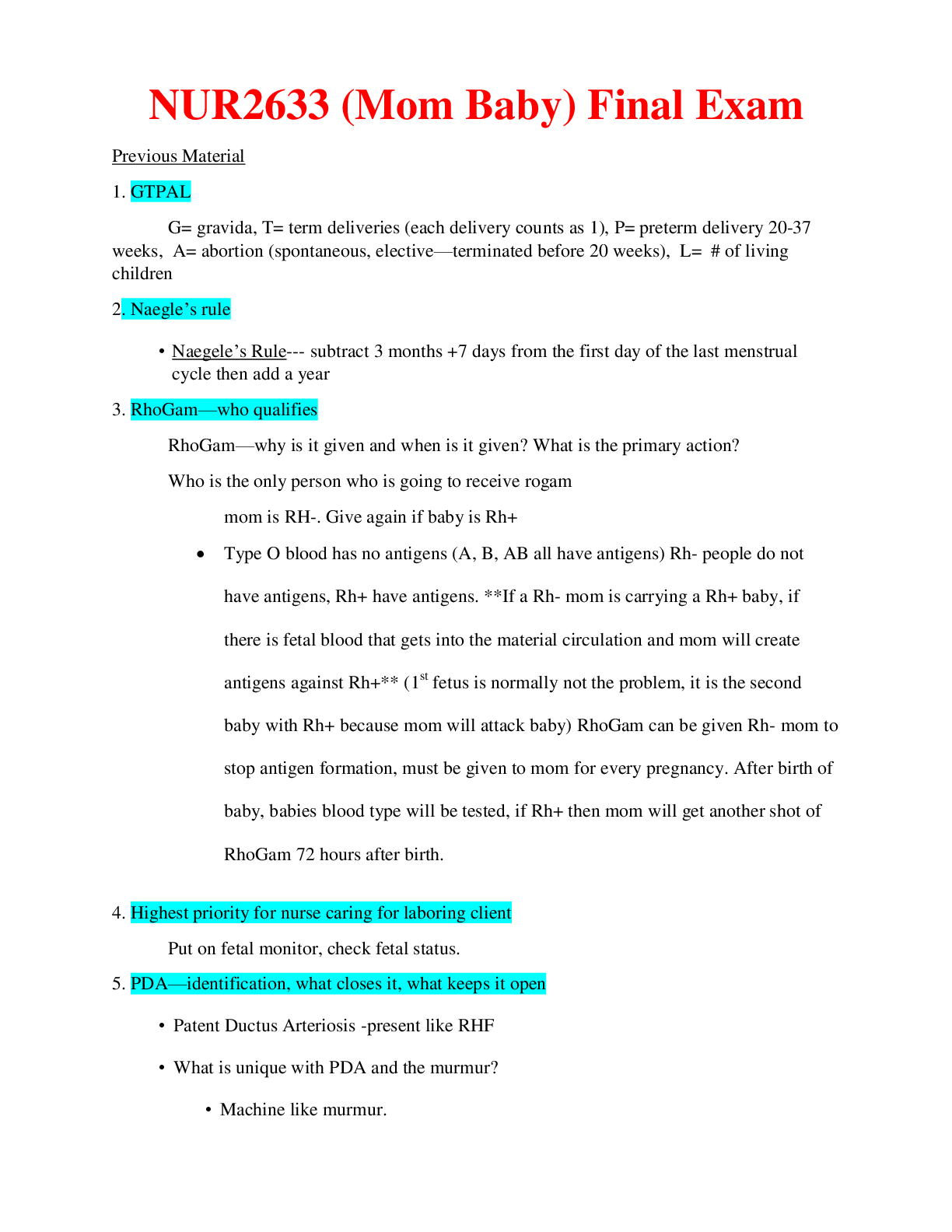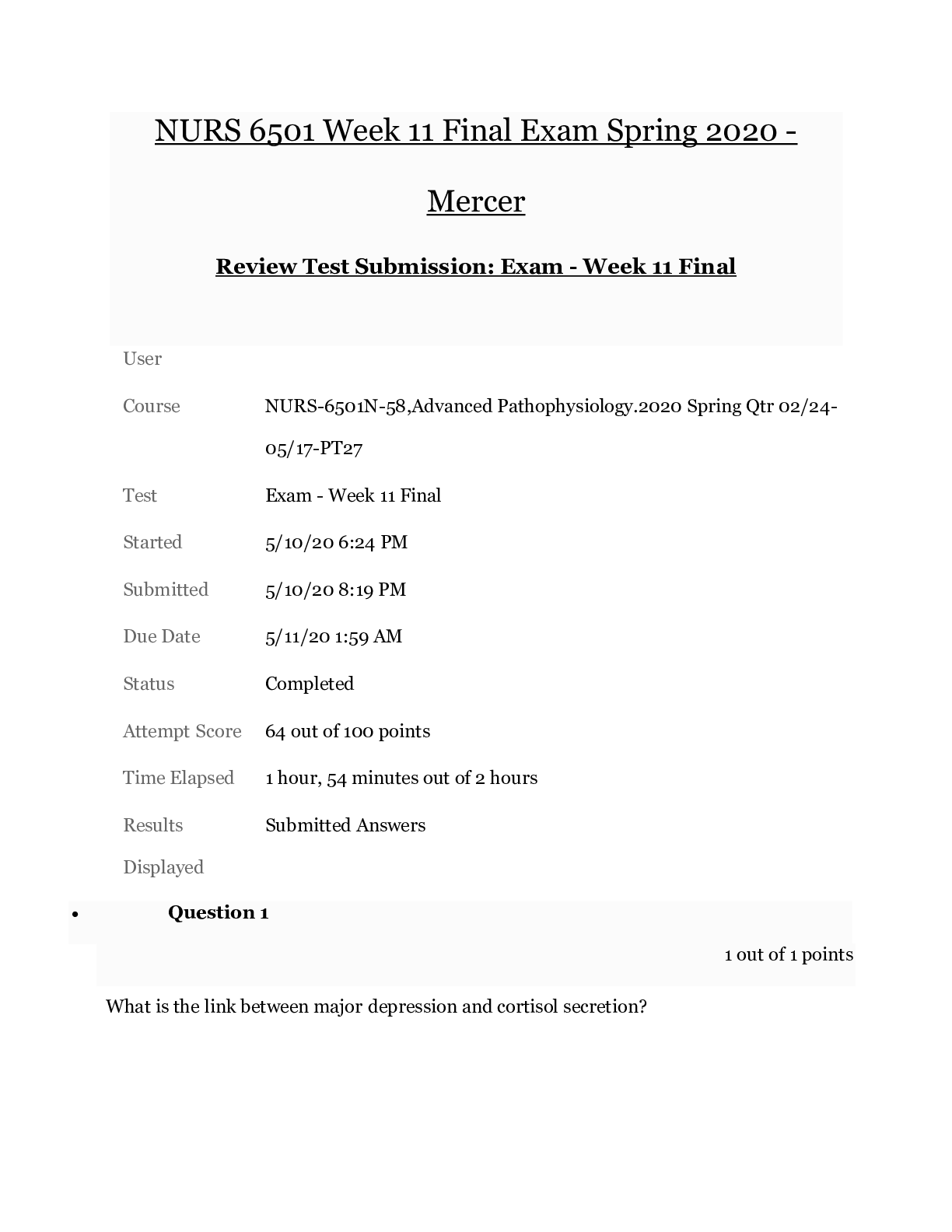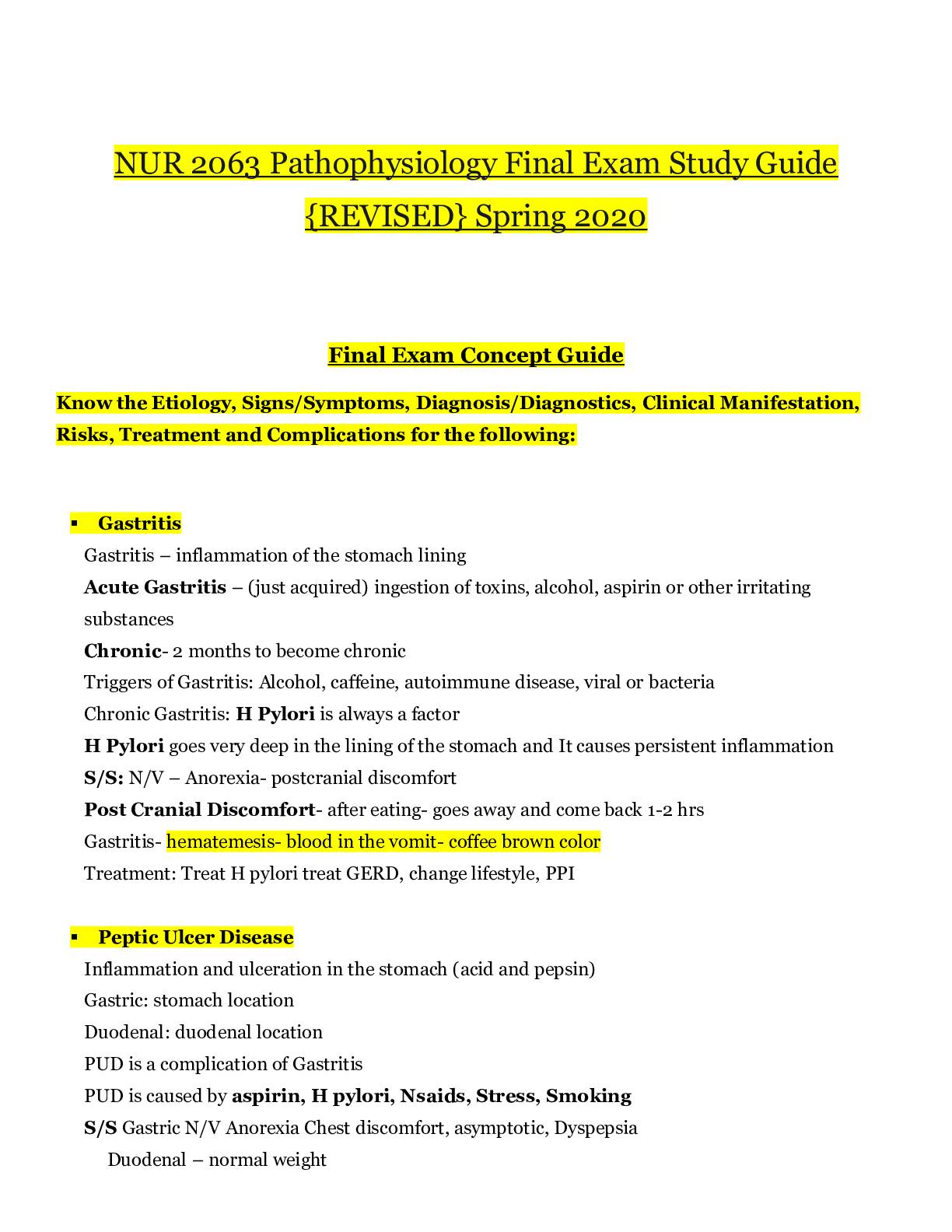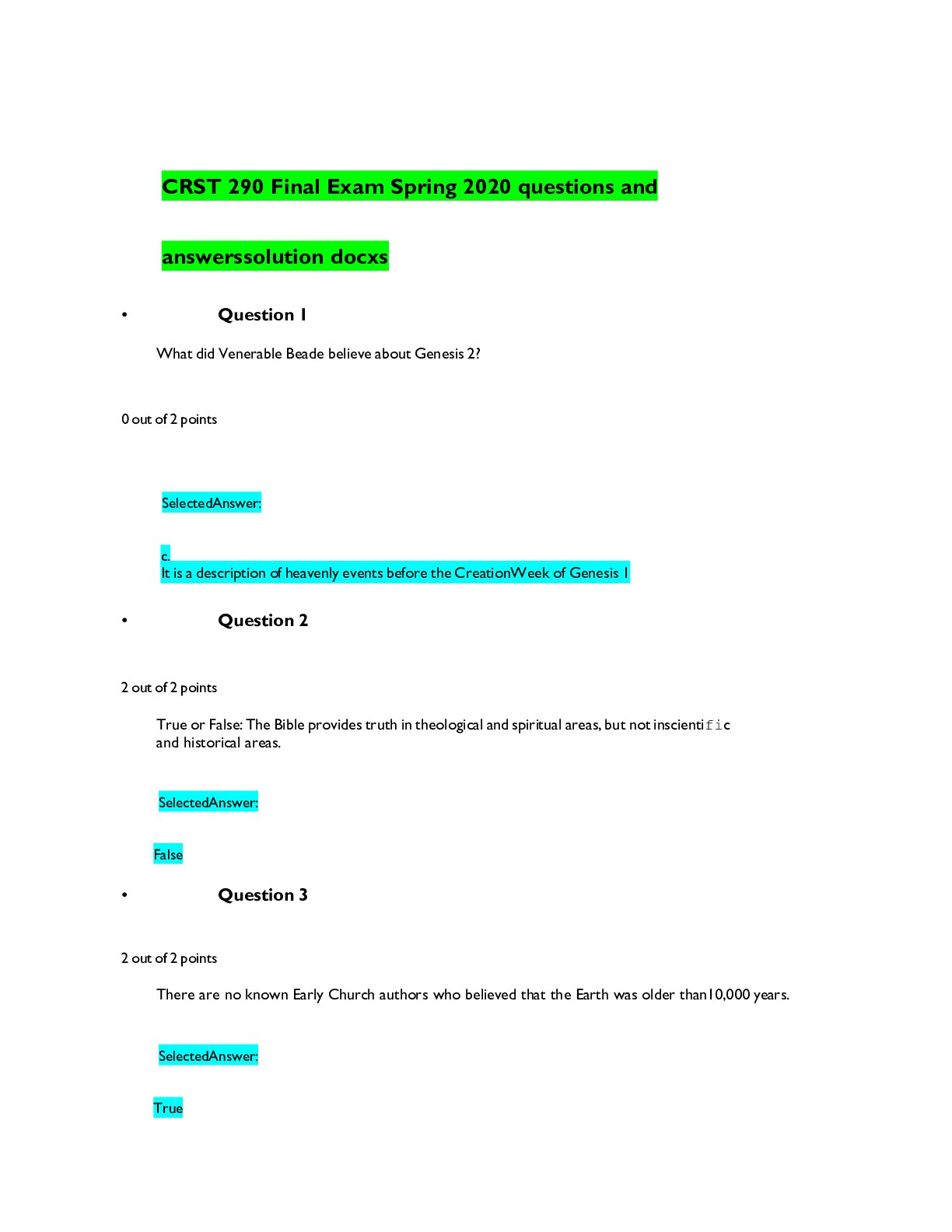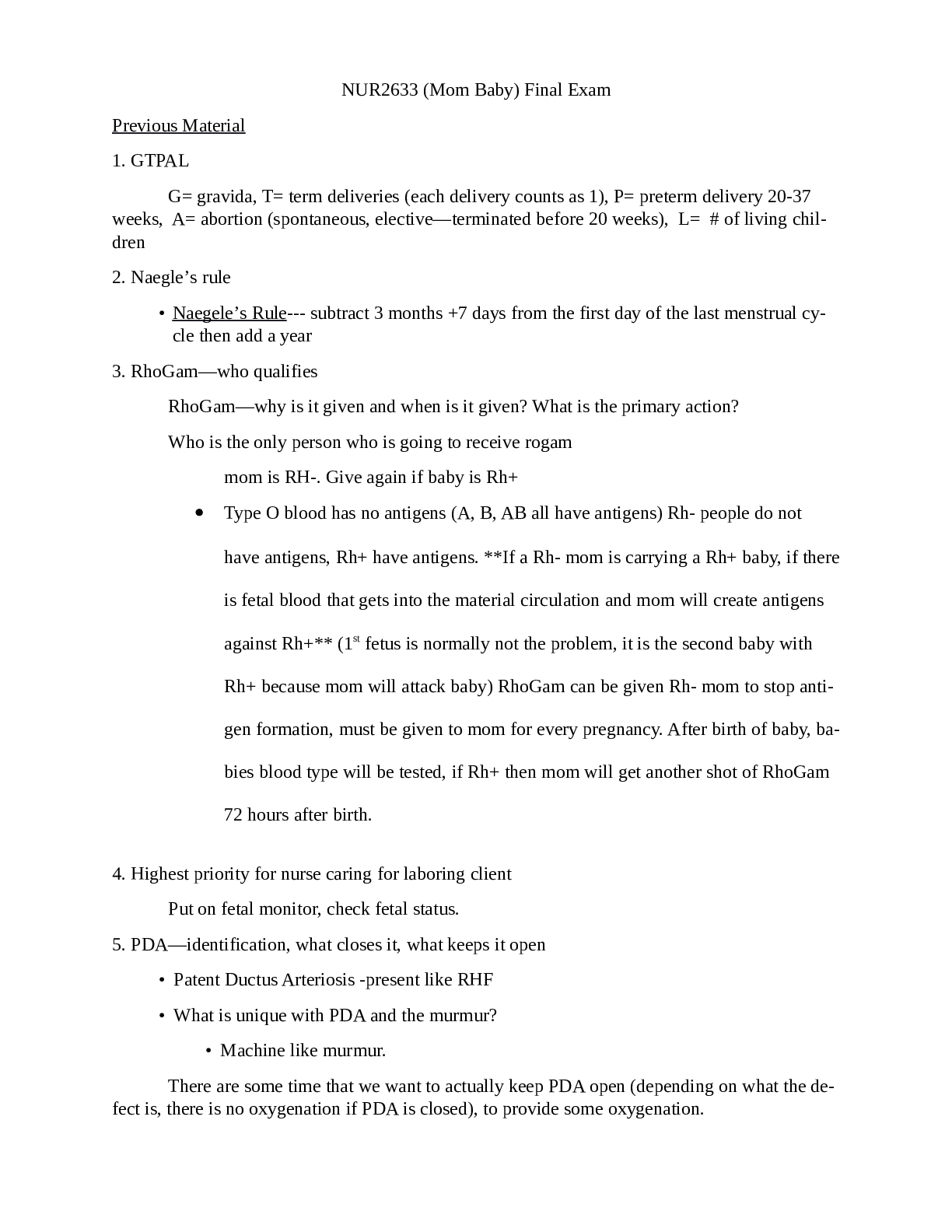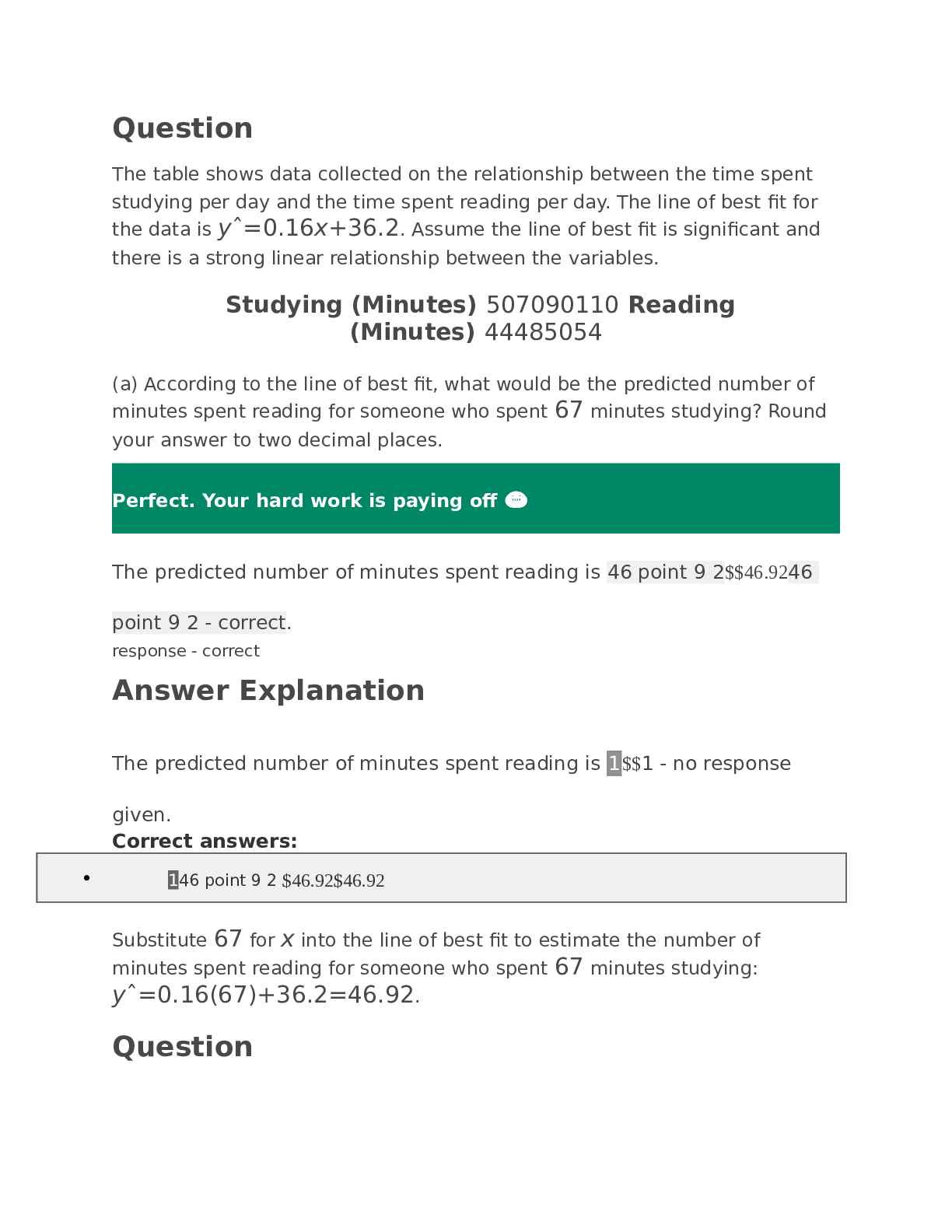NURS 1460 Final exam spring 2019 | NURS1460 Final exam spring 2019
Document Content and Description Below
NURS 1460 Final exam spring 2019 Final exam 1. A client with a history of chronic myelogenous leukemia and splenomegaly is admitted to the hospital. What should the nurse expect to identify when com... pleting the admission assessment? 1 Increased urinary output 2 Tender mass in the left upper abdomen 3 Elevated erythrocytes, platelets, and granulocytes 4 Polydipsia, increased appetite, and urinary frequency Splenomegaly usually accompanies chronic myelogenous leukemia; the spleen usually is gross, palpable, and tender and necessitates removal. The spleen is located high in the abdomen on the left side and usually is not palpable unless it is enlarged. The urinary output is not affected with these conditions. With leukemia and splenomegaly there is increased destruction of blood cells; the erythrocyte count will be low. Polydipsia, increased appetite, and urinary frequency are not associated with leukemia or splenomegaly, but rather diabetes. 2. The client who has a history of allergy to bee stings is brought to the emergency department following a bee sting. What are the interventions to be followed in correct order? 1. Inject epinephrine through the intramuscular route in the mid-portion of the outer thigh. 2. Remove the stinger gently by scraping with a needle. 3. Administer oral liquid diphenhydramine. 4. Establish an intravenous infusion with normal saline. Basic emergency care for bee and wasp stings includes quick removal of the stinger by scraping with a needle. But in the clients who are allergic to bee sting the foremost care that must be given is administration of epinephrine through the intramuscular route in the mid-portion of the outer thigh. After administering epinephrine, the stinger is gently removed by scraping using a needle. Later, oral liquid diphenhydramine is given. If the client has sustained a serious reaction, intravenous infusion with normal saline is established. 3. The nurse is caring for four clients with hypersensitivity reactions. Which client should the nurse suspect to have a type IV hypersensitive reaction? 1 Client A 2 Client B 3 Client C 4 Client D Type IV or delayed hypersensitive reactions are cell-mediated immune responses that involve T lymphocytes, not antibodies. These cause erythema and edema in client D within 24 to 48 hours after a skin test. Type I hypersensitivity reaction is known as an anaphylactic reaction mediated by IgE antibodies; it shows wheal and flare around the site of injection in client A. Type II hypersensitivity reactions are known as cytotoxic reactions that involve IgM and IgG antibodies and show no response to the skin test in client B. Type III hypersensitivity reactions are known as immune-complex reactions that involve IgG and IgM antibodies. These show erythema and edema after 3 to 8 hours of a skin test in client C. Test-Taking Tip: Type IV hypersensitivity reaction is mediated by T lymphocytes. Use this information to select the correct answer. 4. A nurse identifies signs of electrolyte depletion in a client with heart failure who is receiving bumetanide and digoxin. What does the nurse determine is the cause of the depletion? 1 Diuretic therapy 2 Sodium restriction 3 Continuous dyspnea 4 Inadequate oral intake Diuretic therapy that affects the loop of Henle generally involves the use of drugs (e.g., bumetanide) that directly or indirectly increase urinary sodium, chloride, and potassium excretion. Sodium restriction does not necessarily accompany administration of bumetanide. Dyspnea does not directly result in a depletion of electrolytes. Unless otherwise prescribed, oral intake is unaffected. 5. Which electrolyte concentration has the potential to precipitate dysrhythmias and cardiac arrest in a client? 1 Serum sodium of 139 mEq/L (139 mmol/L) 2 Serum chloride of 100 mEq/L (100 mmol/L) 3 Serum calcium of 10.2 mg/dL (2.55 mmol/L) 4 Serum potassium of 7.2 mEq/L (7.2 mmol/L) Hyperkalemia causes dysrhythmias and cardiac arrest. The normal serum potassium concentration ranges between 3.5 and 5.0 mEq/L (3.5-5.0 mmol/L). A concentration of 7.2 mEq/L (7.2 mmol/L) indicates hyperkalemia. The normal concentration of sodium in the serum ranges between 135 and 145 mEq/L (135-145 mmol/L). The normal chloride concentration ranges between 96 and 106 mEq/L (96-106 mmol/L). The normal serum calcium level ranges between 9 and 10.5 mg/dL (2.25-2.625 mmol/L). Test-Taking Tip: You have at least a 25 percent chance of selecting the correct response in multiple-choice items. If you are uncertain about a question, eliminate the choices that you believe are wrong and then call on your knowledge, skills, and abilities to choose from the remaining responses. 6. A nurse is assessing a client and suspects diabetic ketoacidosis (DKA). What clinical findings support this conclusion? 1 Nervousness and tachycardia 2 Erythema toxicum rash and pruritus 3 Diaphoresis and altered mental state 4 Deep respirations and fruity odor to the breath Deep respirations and a fruity odor to the breath are classic signs of DKA, because of the respiratory system's attempt to compensate by blowing off excess carbon dioxide, a component of carbonic acid. Nervousness and tachycardia are indicative of an insulin reaction (diabetic hypoglycemia). When the blood glucose level decreases, the sympathetic nervous system is stimulated, resulting in an increase in epinephrine and norepinephrine; this causes clinical findings such as nervousness, tachycardia, palpitations, sweating, tremors, and hunger. Erythema toxicum rash and pruritus are unrelated to diabetes; they indicate a hypersensitivity reaction. Although an altered mental state is associated with both hypoglycemia and DKA, diaphoresis is associated only with hypoglycemia. Diaphoresis occurs when the blood glucose level decreases and stimulates an increase in epinephrine and norepinephrine. 7. The nurse caring for a client with diabetic ketoacidosis (DKA) can expect to implement which intervention? 1 Intravenous administration of regular insulin 2 Administer insulin glargine subcutaneously at hour of sleep 3 Maintain nothing prescribed orally (NPO) status 4 Intravenous administration of 10% dextrose A client admitted with DKA will have a blood glucose value greater than 250 and blood ketones. Intravenous (IV) administration of regular insulin is needed to rid the body of ketones and regulate blood glucose. Administration of insulin glargine is not going to reverse the ketoacidosis. The client will be allowed fluids to maintain hydration. Administration of 10% dextrose IV will increase the client’s blood glucose. 8. A nurse provides a list of suggested food choices to a client who has peptic ulcer disease. Which foods should be included on the list? 1 Orange juice, fried eggs, and sausage 2 Tomato juice, raisin bran cereal, and tea 3 Applesauce, cream of wheat, and apple juice 4 Sliced oranges, pancakes with syrup, and coffee Applesauce, cream of wheat, and apple juice are bland foods that do not irritate the gastric mucosa. Orange juice, fried eggs, sausage, tomato juice, raisin bran cereal, tea, sliced oranges, and coffee are not bland; they may be irritating to the mucosal lining. Caffeine should be avoided. 9. The nurse observed seizures in a client who is taking lithium for cycles of mania. Which laboratory parameters may lead to this condition? 1 1 mEq/L (1 mmol/L) serum lithium levels 2 3 mEq/L (3 mmol/L) serum lithium levels 3 135 mEq/L (135 mmol/L) serum sodium levels 4 140 mEq/L (140 mmol/L) serum sodium levels Serum lithium levels exceeding 2.5 mEq/L (2.5 mmol/L) may cause seizures, gastrointestinal discomfort, tremors, confusion, and somnolence. Therefore, a serum lithium level of 3 mEq/L (3 mmol/L) serum may lead to seizures. The desired long-term serum lithium level is 1 mEq/L (1 mmol/L). The normal range of serum sodium levels is from 135 to 145 mEq/L (135-145 mmol/L). 10. The nurse reviews the thyroid profiles of four clients. Which client’s finding indicates the possibility of a thyroid tumor? 1 Client A 2 Client B 3 Client C 4 Client D 11. The nurse is caring for a client with complete partial seizures. Put in priority order the care activities performed by the nurse 1. Maintaining airway 2. Recording the time and duration of seizure 3. Assessing vital signs 4. Performing neurologic checks Maintaining the airway is the priority for a client with any type of seizure. Then the nurse should record the time and duration of the seizure to determine the severity of the condition. Then the nurse should assess the client’s vital signs after completion of the seizure. Then the nurse should assess the client’s neurologic status. Test-Taking Tip: In this Question Type, you are asked to prioritize (put in order) the options presented. For example, you might be asked the steps of performing an action or skill such as those involved in medication administration. 12. A nurse is reviewing the laboratory reports of four clients. Which client most likely has rheumatoid arthritis? 1 Client A 2 Client B 3 Client C 4 Client D Erythrocyte sedimentation rate (ESR) is a nonspecific index of inflammation. Its normal value is less than 30 mm/hr. Client D, who has elevated levels of ESR to 65 mm/hr, may present with rheumatoid arthritis, osteomyelitis, rheumatic fever, and respiratory tract infections. Uric acid is an end-product of purine metabolism. The normal range of uric acid is 2.3 to 7.6 mg/dL (137-452 μmol/L). An elevation in the uric acid value in client A to 8.5 mg/dl may result in gout. The normal value of C-reactive protein (CRP) is 6.8-820 mcg/dL (68-8200 mcg/L). Client B, who presents with a normal level of CRP at 800 mcg/dL (8000 mcg/L), will not have inflammatory diseases, infections, and active, widespread malignancy. The normal value of anti-deoxyribonucleic acid (DNA) antibody is less than 70 IU/mL; it helps to detect serum antibodies that react with DNA. Client D, who has elevated levels of anti-DNA antibody at 90 IU/mL, may be more susceptible to systemic lupus erythematosus (SLE). 13. A client who is suspected of having leukemia has a bone marrow aspiration. What should the nurse do Immediately after the procedure? 1 Apply brief pressure to the site. 2 Have the client lie on the affected side. 3 Swab the site with an antiseptic solution. 4 Monitor vital signs every hour for 4 hours. Brief pressure is generally enough to prevent bleeding at the aspiration site. Complications are rare; no special positions are required. The site is cleaned before aspiration. Frequent monitoring is unnecessary. Test-Taking Tip: Never leave a question unanswered. Even if answering is no more than an educated guess on your part, go ahead and mark an answer. You might be right, but if you leave it blank, you will certainly be wrong and lose precious points. 14. A client is diagnosed with a peptic ulcer. When teaching about peptic ulcers, the nurse instructs the client to report what kind of stools? 1 Frothy 2 Ribbon shaped 3 Pale or clay colored 4 Dark brown or black Dark brown or black stools (melena) indicate gastrointestinal bleeding and need to be reported. Frothy stools are indicative of inadequate fat absorption and are associated with sprue. Ribbon-shaped stools indicate a bowel mass or obstruction. Clay-colored stools usually are related to problems that cause a decrease in bile. 15. While performing a respiratory assessment of a client with pneumonia, a nurse hears these sounds. What should the nurse document in the client’s medical record? 00:00/00:16 1 Rhonchi 2 Fine crackles 3 Coarse crackles 4 Pleural friction rubs Pleural friction rubs are creaking or grating sounds caused by roughened, inflamed pleural surfaces rubbing together. They are associated with pleurisy, pneumonia, or a pulmonary infarct and can be heard during inspiration, expiration, or both. Rhonchi are continuous rumbling, snoring, or rattling sounds that occur due to obstruction of large airways with secretions. Fine crackles are a series of short-duration, discontinuous, high-pitched sounds caused by rapid equalization of gas pressure when collapsed alveoli or terminal bronchioles suddenly snap open. They are heard just before the end of inspiration. Coarse crackles are series of long-duration, discontinuous, low-pitched sounds associated with pulmonary edema or pneumonia with severe congestion. They sound like air is blowing through a straw underwater. 16. A client is taking phenytoin to treat clonic-tonic seizures. The client's phenytoin level is 16 mcg/L. Which action should the nurse take? 1 Hold the medication and notify the healthcare provider. 2 Administer the next dose of the medication as prescribed. 3 Hold the next dose and then resume administration as prescribed. 4 Call the healthcare provider to obtain a prescription with an increased dose. Administering the next dose of the medication as prescribed is within the therapeutic range of 10 to 20 mcg/L (40 to 80 mcmol/L); the nurse should administer the drug as prescribed. The phenytoin level is within the therapeutic range of 10 to 20 mcg/L (40–80 mcmol/L); there is no need to hold the dose and notify the healthcare provider. Holding the next dose and then resuming administration as prescribed is unsafe and will reduce the therapeutic blood level of the drug. Calling the healthcare provider to obtain a prescription with an increased dose is unnecessary; the blood level is within the therapeutic range. 17. Which metabolic manifestations are likely to be observed in a client with hypothyroidism? Select all that apply. 1 Impaired memory 2 Intolerance to cold 3 Difficulty breathing 4 Decreased blood pressure 5 Decreased body temperature Cold intolerance and decreased body temperature are the metabolic manifestations observed in a client with hypothyroidism. Impaired memory is the neuromuscular manifestation of hypothyroidism. Difficulty in breathing is the pulmonary manifestation observed in the client with hypothyroidism. Decreased blood pressure is the cardiovascular manifestation observed in the client with hypothyroidism. 18. The healthcare team is caring for a client who has undergone surgery for lung cancer. The client needs respiratory therapy. Which task can be safely delegated to a respiratory therapist paired with a registered nurse? 1 Placing a Foley catheter 2 Assessing the respirations 3 Placing an intravenous (IV) catheter 4 Administering patient-controlled analgesia Respiratory therapy is needed in clients who undergo surgery for lung cancer. Assessing respiration can be safely delegated to the respiratory therapist. Placing a Foley catheter, an IV catheter, or administering patient-controlled analgesia is within the scope of a registered nurse’s practice. 19. A nurse is assessing a client with a diagnosis of kidney failure for clinical indicators of metabolic acidosis. What should the nurse conclude is the reason metabolic acidosis develops with kidney failure? 1 Inability of the renal tubules to secrete hydrogen ions and conserve bicarbonate 2 Depressed respiratory rate due to metabolic wastes, causing carbon dioxide retention 3 Inability of the renal tubules to reabsorb water to dilute the acid contents of blood 4 Impaired glomerular filtration, causing retention of sodium and metabolic waste products Bicarbonate buffering is limited, hydrogen ions accumulate, and acidosis results. The rate of respirations increases in metabolic acidosis to compensate for a low pH. The fluid balance does not significantly alter the pH. The retention of sodium ions is related to fluid retention and edema rather than to acidosis. 20. An older client who was found unconscious at home was admitted to the hospital with a fractured hip, renal failure, and dehydration. In the 24 hours since admission, the client has received 3 L of intravenous fluid. The client has also developed hyponatremia. Which element would the nurse conclude is the most likely to have contributed to the client developing hyponatremia? 1 Reduced dietary salt intake 2 Intravenous fluid infusion 3 Potassium reabsorption rate 4 Increased glomerular filtration Hemodilution has most likely occurred because 3 L of intravenous fluid will lower the serum sodium level by increasing intravenous fluid and reducing the serum concentration of sodium. A reduced dietary salt intake is not the most likely cause of hyponatremia developing during the first 24 hours of this hospitalization. Changes to the serum potassium reabsorption rate are not likely to have caused hyponatremia in the last 24 hours. A decreased, not increased, glomerular filtration rate occurs with renal failure. Test-Taking Tip: Read every word of each question and option before responding to the item. Glossing over the questions just to get through the examination quickly can cause you to misread or misinterpret the real intent of the question. 21. A client with a parathyroid disorder reports nausea, vomiting, weight loss, and epigastric pain. Which electrolyte disturbance would be responsible for the client’s clinical manifestations? 1 Hypercalcemia 2 Hypernatremia 3 Hypermagnesemia 4 Hyperphosphatemia High levels of calcium in the serum cause nausea, vomiting, weight loss, and epigastric pain (pain in the upper abdomen). Therefore the client may have hypercalcemia. Hypernatremia is manifested as altered cerebral functioning. Hypermagnesemia is manifested as bradycardia, peripheral vasodilation, and hypotension. Hyperphosphatemia is manifested as hypocalcemia that results when serum phosphorus levels increase. 22. A client on diuretic therapy developed metabolic alkalosis. What does the nurse consider to be the priority nursing care while correcting alkalosis? 1 Preventing falls 2 Monitoring electrolytes 3 Administering antiemetics 4 Adjusting the diuretic therapy A client with alkalosis has hypotension and muscle weakness, which increases the risk for injury due to falls; therefore, to prevent injury, the priority nursing care is to prevent falls. Monitoring electrolytes daily until they return to normal is not the priority nursing care. Antiemetics are prescribed for vomiting and are given low priority. Once the client is protected from the risk of injury, diuretic therapy is adjusted. 23. A client is admitted with severe diarrhea that resulted in hypokalemia. The nurse should monitor for what clinical manifestations of the electrolyte deficiency? Select all that apply. 1 Diplopia 2 Skin rash 3 Leg cramps 4 Tachycardia 5 Muscle weakness Leg cramps occur with hypokalemia because of potassium deficit. Muscle weakness occurs with hypokalemia because of the alteration in the sodium potassium pump mechanism. Diplopia does not indicate an electrolyte deficit. A skin rash does not indicate an electrolyte deficit. Tachycardia is not associated with hypokalemia; bradycardia is. 24. A client is diagnosed with acute lymphoid leukemia and is receiving chemotherapy. The nurse should monitor what thrombocytopenic side effects of chemotherapy? Select all that apply. 1 Nausea 2 Melena Correct 3 Purpura 4 Diarrhea [Show More]
Last updated: 1 year ago
Preview 1 out of 79 pages
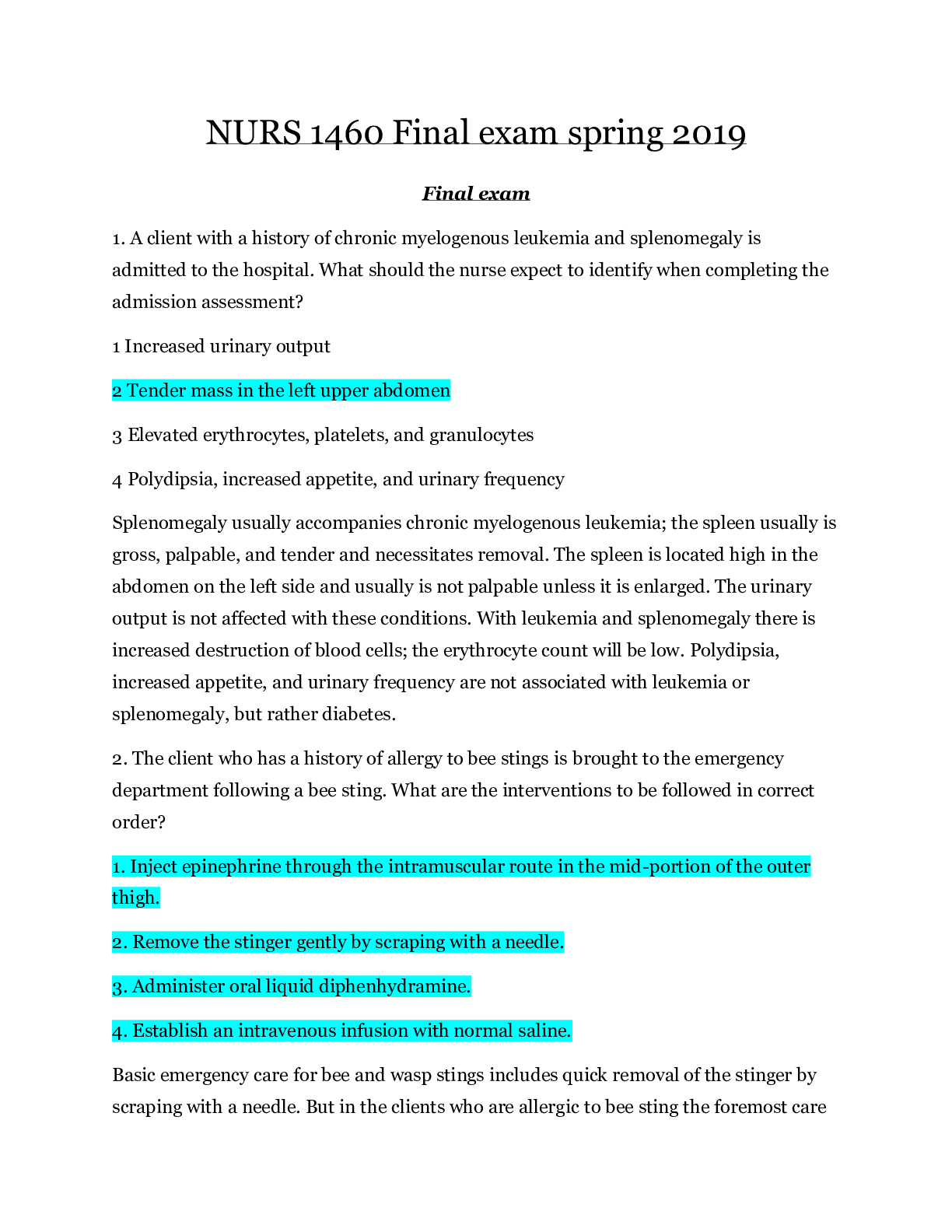
Buy this document to get the full access instantly
Instant Download Access after purchase
Add to cartInstant download
We Accept:

Reviews( 0 )
$15.50
Document information
Connected school, study & course
About the document
Uploaded On
Jun 19, 2020
Number of pages
79
Written in
Additional information
This document has been written for:
Uploaded
Jun 19, 2020
Downloads
0
Views
80














